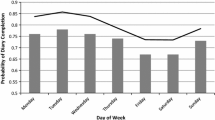Abstract
By comparing four similar groups of young adolescent males who completed questionnaires about their sexual behavior different numbers of times at various intervals, we explore the hypothesis that repeated questionnaire completion will affect sexual behavior. We find little support for the hypothesis even when the number of questionnaire administrations is very high.
Similar content being viewed by others
References
Campbell, D. T., and Stanley, J. C. (1966).Experimental and Quasi-Experimental Designs for Research Rand McNally College Publishing Company, Chicago.
Cane, V. R., and Heim, A. W. (1950). The effects of repeated retesting: III. Further experiments and general conclusions.Quart. J. Exp. Psychol. 2: 182–195.
Fujita, B. N., Wagner, N. N., Perthou, N., and Pion, R. J. (1971). The effects of an interview on attitudes and behavior.J. Sex Res. 7: 138–152.
Kraut, R. E., and McConahay, J. B. (1973). How being interviewed affects voting: An experiment.Public Opin. Quart. 36: 98–406.
McFall, R. M. (1970). Effects of self-monitoring on normal smoking behavior.J. Consult. Clin. Psychol. 35: 135–142.
Morris, N. M., and Udry, J. R. (1980). Validation of a self-administered instrument to assess stage of adolescent development.J. Youth Adolescence 9: 271–280.
Persky, H., Strauss, D., Lief, H. I., Miller, W. R., and O'Brien, C. P. (1981). Effect of the research process on human sexual behavior.J. Psychiat. Res. 16: 41–52.
Reading, A. E. (1983). A comparison of the accuracy and reactivity of methods of monitoring male sexual behavior.J. Behav. Assess. 5: 11–23.
Rubin, Z., and Mitchell, C. (1976). Couples research as couples counseling: Some unintended effects of studying close relationships.Am. Psychol. 31: 17–25.
Schuldberg, D. (1988). The MMPI is less sensitive to the Automated Testing Format that it is to repeated testing: Item and scale effects.Comput. Hum. Behav. 4: 285–298.
Snedecor, G. W., and Cochran, W. G. (1967).Statistical Methods Iowa State University Press, Ames.
Sonenstein, F. L., Pleck, J. H., and Ku, L. C. (1991). Levels of sexual activity among adolescent males in the United States.Fam. Plann. Perspect. 23(4): 162–167.
Willson, V. L., and Putnam, R. R. (1982). A meta-analysis of pretest sensitization effects in experimental design.Am. Educ. Res. J. 19: 249–258.
Windle, C. (1954). Test-retest effect on personality questionnaires.Educ. Psychol. Measur. 14: 617–633.
Author information
Authors and Affiliations
Additional information
This research was supported by a research grant (HD12806) from the National Institute of Child Health and Human Development (NICHD), centers grants from NICHD to the Laboratories for Reproductive Biology (HD18968) and the Carolina Population Center (HD05798), and a Clinical Research Unit Grant (RR00046) from the National Institutes of Health.
Rights and permissions
About this article
Cite this article
Halpern, C.T., Udry, J.R. & Suchindran, C. Effects of repeated questionnaire administration in longitudinal studies of adolescent males' sexual behavior. Arch Sex Behav 23, 41–57 (1994). https://doi.org/10.1007/BF01541617
Issue Date:
DOI: https://doi.org/10.1007/BF01541617



